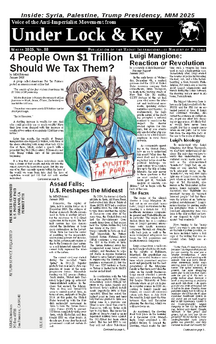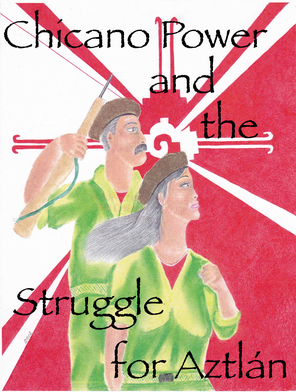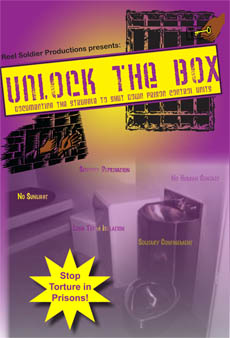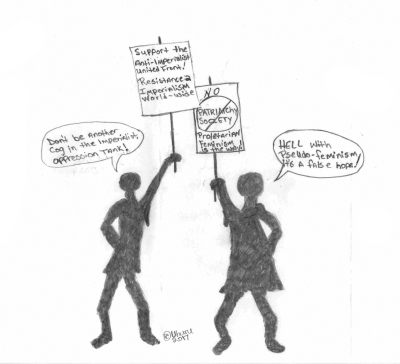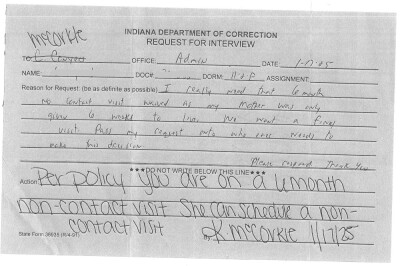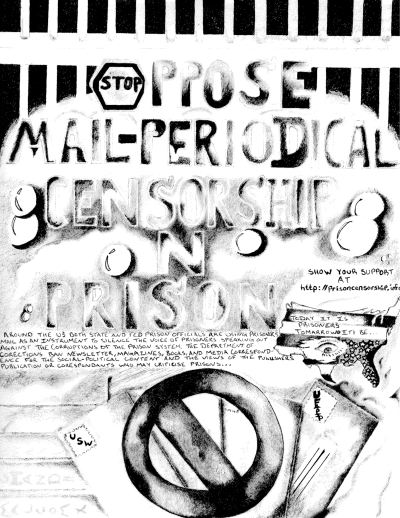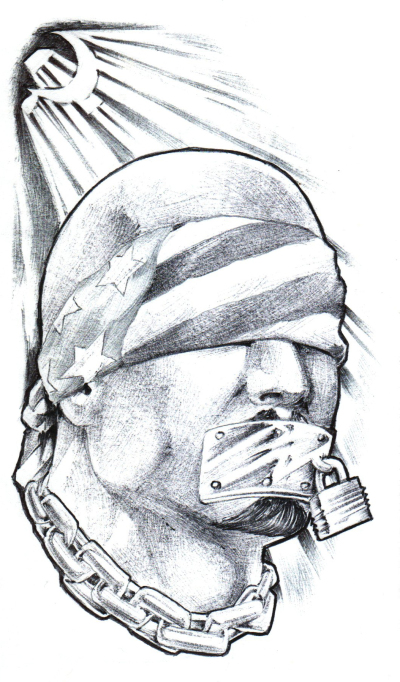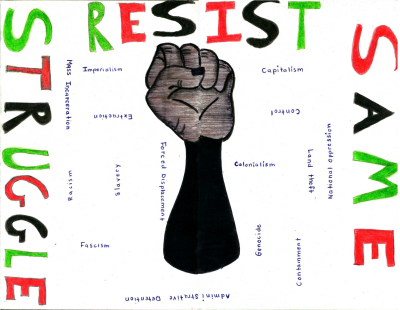
Deportaciones Persigue Esos Protestando Genocidio y Huyendo de Violencia Imperialista
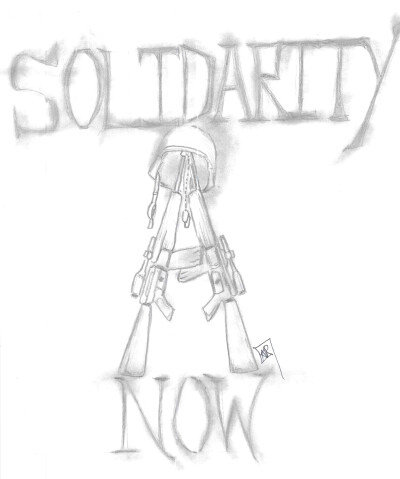
Intensificando la amenaza de pandillas peligrosas con “súperpredadores.” Usando informantes confidenciales, tatuajes, y apariencia para catalogar personas como “pandilleros.” Usando esa conexión de pandilla para encarcelar y torturar a la gente. Estos métodos draconianos son familiares a lectores de ULK, y para esos que han pasado tiempo en cárceles estadounidenses en general. El régimen de Trump ha echo esta noticia para el país entero.
En las semanas recientes, cientos de venezolanos han sido deportados de los Estados Unidos a una megacarcel en El Salvador. El régimen de Trump ha justificado esto con La Ley de Enemigos de 1798, que permite la deportación de no ciudadanos durante tiempo de guerra, y fue usado durante la Segunda Guerra Mundial para deportar los alemanes y italianos y juntar los japoneses en campos de internamiento, apoderándose de sus activos para los euro-amerikanos. Trump reclamo que estas personas fueron parte de una pandilla conduciendo “guerra irregular” en los Estados Unidos, pero no hay evidencia que Tren de Aragua es una organización amplia y funcional aquí. En febrero, el Departamento de Estado estadounidense designaron Tren de Aragua, Mara Salvatrucha (MS-13), y una lista de carteles mexicanas como “organizaciones terroristas extranjeras.”
Una corte federal ha ordenado una pausa a estas deportaciones, pero el Departamento de Justicia esta desafiando la orden. Una batalla legal continua, mientras el poder ejecutivo continua a desafiar las cortes.
Venezuela ha sido un objetivo consistente del imperialismo estadounidense desde que obtuvo poder Hugo Chávez en 1999.(1) De resultado casi 600,000 venezolanos han sido aceptados en los Estados Unidos con Estatus Protegido Temporario (TPS). Trump intento a cancelar el TPS para los venezolanos, pero una corte federal ha determinado eso como un acto ilegal. Sin el TPS, muchos de Venezuela, Haití, Ucrania, Sudán, Afganistán y otros lugares no podrían continuar a trabajar en los Estados Unidos legalmente y podrían ser deportados legalmente.
Kilmar Armando Ábrego García esta recibiendo atención especial de que la administración de Trump admitió que su deportación fue un error, y que no lo pueden regresar de la custodia salvadoreña. Esto es a pesar de que había una orden del la corte que prevenía su regreso a El Salvador, donde se había escapado de violencia pandillera cuando era joven. Ábrego García no tiene cargos criminales, si sirve de algo, pero fue catalogado como un miembro de MS-13 por un cerdo mencionando un “informante confidencial” cuando estaban acorralando trabajadores hace algunos años. Como resultado, Ábrego García ha sido desaparecido de su familia y mandado a una unidad de tortura en el mero país que huyo por razones de seguridad.(2)
El ACLU obtenido una copia del “Alien Enemy Validation Guide” siendo usado para deportaciones. Después de establecer que alguien es mayor de los 14 años, de origen Venezolano y sin ciudadanía estadounidense, un sistema de puntuación es usado para “validar” pandilleros. Un tatuaje de “TdA” te da 4 puntos mientras 8 puntos son requeridos para calificar como validado. La guiá del Departamento de Seguridad Nacional muestra una lista de imágenes de tatuajes como coronas y estrellas que son “TdA”. También, poniéndote mercancía de los Chicago Bulls y Michael Jordan está en la lista. Cuando fue la ultima vez que has visto alguien con un tatuaje de una estrella y portando Air Jordans?
Persiguiendo Activistas Estudiantiles
Instituciones educacionales desde Universidad de Columbia en Nueva York hasta es sistema de la Universidad de California están esforzando la represión fascista en sus campos, de expulsando estudiantes durante la presidencia de Biden, a haciéndolos desaparecer de las calles y de sus hogares bajo el régimen de Trump. Estudiante de Tufts University Rümeysa Öztürk esta detenida por escribiendo un articulo criticando el genocidio en Palestina causado por los Estados Unidos y Israel y el campamento estudiantil propalestina el año pasado, contó su historia en una declaración reciente del 18 de Marzo 2025:
“Me llamo Mahmoud Khalil y soy un preso político. Les escribo desde un centro de detención en Luisiana… Fui detenido el 8 de marzo por unos agentes del Departamento de Seguridad Nacional (DHS, por sus siglas en inglés). Se negaron a aportar una orden judicial y nos abordaron a mi esposa y a mí de manera agresiva cuando regresábamos de cenar.…
“Mi detención fue una consecuencia directa de ejercer mi derecho a la libre expresión, ya que abogaba por una Palestina libre y el fin del genocidio en Gaza; genocidio que se reanudó con fuerza el lunes por la noche. Con el acuerdo de alto al fuego que se pactó en enero ya roto, los padres y madres de Gaza vuelven a mecer mortajas minúsculas en sus brazos y las familias se han visto obligadas a escoger entre la hambruna y el desplazamiento forzoso o las bombas. Es nuestro imperativo moral persistir en la lucha por su libertad absoluta.”
“[La Universidad de] Columbia me fichó por mi activismo y abrió una dictatorial oficina disciplinaria con el fin de saltarse el debido proceso y silenciar a los estudiantes criticando a Israel. Columbia ha cedido ante las presiones estatales, proporcionando expedientes académicos de sus estudiantes al Congreso y acatando las últimas amenazas de la administración de Trump. Algunos ejemplos claros de esto son mi detención, así como la expulsión o suspensión de al menos veintidós estudiantes de la Columbia —algunos despojados de sus títulos pocas semanas antes de graduarse— y la expulsión de Grant Miner, presidente del sindicato Estudiantes Trabajadores de Columbia (SWC, por sus siglas en inglés), en la víspera de las negociaciones contractuales.”
“En todo caso, mi detención es un testimonio de la fuerza del movimiento estudiantil para cambiar la opinión pública hacia la liberación palestina…” (4)
Otros estudiantes que han sido perseguidos se han escondido. A la misma vez, estudiantes por todas partes del país están uniéndose para apoyar y defender los que puedan ser destacados después. Elogiamos la solidaridad que estamos viendo. Escuelas y prisiones son realmente únicos en nuestra sociedad dado de las identidades de sus poblaciones y sus habilidades a organizar. Con los anuncios recientes del régimen de Trump que van a deportar ciudadanos estadounidenses con récord criminal al Centro de Confinamiento del Terrorismo en El Salvador, prisioneros tienen que estar preparados para confrontar el enemigo juntos en la manera que lo están aprendiendo a hacer los estudiantes. Aunque hay muchos ejemplos recientes que dice lo contrario, hay una historia larga de prisioneros estadounidenses apoyándose debido a la consciencia del grupo que viene con confrontando un opresor común cada día.
Fascismo De Regreso a su Hogar
Los Estados Unidos ha usado el régimen de aislamiento de largo plazo por décadas a un nivel no visto en cualquier otra parte en la historia humana. Médicos para los Derechos Humanos (PHR por sus siglas en inglés) salieron con un reporte en 2024 exponiendo el uso del régimen de aislamiento en los centros de detención en contra de las direcciones del gobierno para limitar su uso cuando es absolutamente necesario. Documentaron alrededor de 14,000 casos de personas siendo puestas en aislamiento por ICE de 2018 a 2023. El régimen de aislamiento tardaba por un promedio de 27 días, con 42 casos tardando mas de un año. En 2024, ICE detuvo mas de 35,000 personas, ahora siendo el sistema de detención inmigratoria mas grande del mundo.(5)
Condiciones probablemente son peor para los que son transferidos a El Salvador, donde el Presidente Bukele ha declarado que la única manera que los pandilleros pueden salirse del Centro de Confinamiento del Terrorismo (CECOT) que construyo en 2023 sera en un cajón. Con una capacidad de mas de 40,000, hay 65 a 70 prisioneros mantenidos en cada celda. “Prisioneros de CECOT no reciben visitas y nunca están permitidos a salir. La prisión no ofrece talleres o programas educativas para prepararlos a regresar a la sociedad después de sus sentencias.”(6) Bukele ha estado promocionando fotos de pandilleros con la cabeza rasurada, vestidos de todo blanco, siendo maltratados por guardas enmascarados por linea desde que abrieron la prisión. Esta campaña de propaganda ha apelado a los elementos profascista de Amerika. Y con ese apoyo, Trump esta incorporando esta prisión en el sistema internacional de prisiones amerikanas y mandando cienes de personas ahí de los Estados Unidos. Este es un cambio cerca de la casa del interconexión de sitios oscuros, y prisiones famosas como Abu Ghraib y Guantánamo, que fueron usados para torturar y aguantar preso sin juicio personas oprimidas al través del mundo Musulmán.
La mayoría de la prensa están reportando que los amerikanos pagaron $6 millón dólares para que 238 prisioneros sean puestos en CECOT, que algunos señalan que es mucho menos de lo que costaría a encarcelarlos en los Estados Unidos. Pero es una cantidad que va a ayudar El Salvador inmensamente para que puedan fundar su monstruosidad de cárcel. No tiene sentido que los imperialistas están pagando para que aguanten a estos prisioneros, pero después reclamen que no pueden regresar personas como Ábrego García de regreso a sus familias.
En los 1980s, los Escuadrones de La Muerte patrocinados por los Estados Unidos, entrenados en la Escuela de las Américas en Georgia, mataron y desplazaron muchas personas en América Central que estaban luchando por el socialismo y por poder sacar el imperialismo de sus países.(7) Muchos niños de esta guerra en El Salvador fueron desplazados a Los Angeles donde se unieron a Barrio 18 o crearon la nueva Mara Salvatrucha (MS-13), fueron perseguidos por el estado, y después mandados a regreso a El Salvador. Reportamos sobre los esfuerzos en haciendo paz entre estos grupos en 2013, que coincide con la inversión por USAID y el desarrollo de las prisiones en El Salvador inspiradas por los Estados Unidos.(8) Pero las condiciones para la gente de El Salvador no mejoraron, y votaron por el Presidente Nayib Bukele que utilizo las organizaciones lumpen en su organización política y después los traiciono como un chivo expiatorio por el mal del país en una campaña fascista de represión.(9)
La lucha contra el fascismo en este país depende en la reunión de personas para defender las poblaciones migrantes y estudiantes que están siendo atacados en este momento. En cuanto el fascismo continué a subir, vemos las campañas de grupos como el ACLU acercándose mas a los de MIM(Prisons). Mientras están pasando batallas legales importantes, también vemos el reconocimiento extendiendo que no podemos depender en las cortes para que nos salven. Debemos de tener un plan B. Debemos de crear nuestro plan B.
Notas:
1. Soso of MIM(Prisons), January 2019,
Imperialists Push Coup in Venezuela to Secure Oil for Amerikans, Under
Lock & Key 67.
2. Democracy Now!, 2 April 2025.
3.
https://www.wlrn.org/immigration/2025-03-31/ice-tren-de-aragua-venezuela-deportation-el-salvador
4.
https://www.aclu.org/news/free-speech/a-letter-from-palestinian-activist-mahmoud-khalil
5. Physicians for Human Rights, 6 February 2024,
https://www.wlrn.org/immigration/2025-03-31/ice-tren-de-aragua-venezuela-deportation-el-salvador.
6. Aleman & Cano, 17 March 2025, “What to know about El Salvador’s
mega-prison after Trump sent hundreds of immigrants there”, Los Angeles
Times.
7. MIM(Prisons), June 2009, FBI Arrests Peacemaker, Under
Lock & Key 9.
8. MIM(Prisons), March 2013, One-Year Anniversary
of Peace Treaty in El Salvador, Under Lock & Key 31.
9. Badgreen
of MIM(Prisons), September 2023, 8,000 Military and Police Deployed in
Cabanas Province, El Salvador, Under Lock & Key 83.
